Research on Two Improved High–Voltage–Transfer–Ratio Space–Vector Pulse–Width–Modulation Strategies Applied to Five–Phase Inverter
Abstract
:1. Introduction
2. Topological Structure and Space Voltage Vector Operating Principle of Five–Phase Inverter
2.1. Main Circuit Topology and Basic Modulation Modulation Strategy
2.2. Operating Principle of Five–Phase SVPWM
2.2.1. Nearest–Two–Vector SVPWM (NTV–SVPWM)
2.2.2. Nearest–Two–Vector SVPWM (NTV–SVPWM)
3. Harmonic Characteristics of Output Voltage of Traditional Space Voltage Vector Modulation
3.1. NTV–SVPWM
3.2. NFV–SVPWM
4. Two Improved SVPWM Strategies Based on Multi–Vector Weighting
4.1. SVPWM Strategy One
4.1.1. Working Principle
4.1.2. Harmonic Characteristics
4.2. SVPWM Strategy Two
4.2.1. Working Principle
4.2.2. Harmonic Characteristics
5. Simulation Research and Experimental Verification
5.1. Simulation Results
5.2. Experimental Verification
6. Conclusions and Prospects
Author Contributions
Funding
Data Availability Statement
Conflicts of Interest
References
- Liu, G.; Song, C.; Chen, Q. FCS–MPC– based fault–tolerant control of five–phase IPMSM for MTPA operation. IEEE Trans. Power Electron. 2020, 35, 2882–2894. [Google Scholar] [CrossRef]
- Yu, B.; Song, W.; Guo, Y. A Simplified and Generalized SVPWM Scheme for Two–Level Multiphase Inverters with Common–Mode Voltage Reduction. IEEE Trans. Ind. Electron. 2022, 69, 1378–1388. [Google Scholar] [CrossRef]
- Barrero, F.; Bermudez, M.; Duran, M.J.; Salas, P.; Gonzalez–Prieto, I. Assessment of a Universal Reconfiguration–less Control Approach in Open–Phase Fault Operation for Multiphase Drives. Energies 2019, 12, 4698–4709. [Google Scholar] [CrossRef]
- Liu, G.; Song, C.; Xu, L.; Du, K. SVPWM–based fault–tolerant control strategy under two–phase open–circuit fault of five–phase permanent–magnet synchronous motor. Trans. China Electrotech. Soc. 2019, 34, 23–32. [Google Scholar]
- Tian, B.; Mirzaeva, G.; An, Q.T.; Sun, L.; Semenov, D. Fault–tolerant control of a five–phase permanent magnet synchronous motor for industry applications. IEEE Trans. Ind. Appl. 2018, 54, 3943–3952. [Google Scholar] [CrossRef]
- Liu, Z.; Li, Y.; Zheng, Z. Control and drive techniques for multiphase machines: A review. Trans. China Electrotech. Soc. 2017, 32, 17–29. [Google Scholar]
- Liu, Z.; Zheng, Z.; Li, Y. Enhancing fault–tolerant ability of a nine–phase induction motor drive system using fuzzy logic current controllers. IEEE Trans. Energy Convers. 2017, 32, 759–769. [Google Scholar] [CrossRef]
- Wang, Y.; Wang, Z. A novel spatial vector modulation strategy for multiphase three–level inverters based on vector space decoupling. Proc. CSEE 2018, 38, 3316–3324. [Google Scholar]
- Bermudez, M.; Gonzalez–Prieto, I.; Barrero, F.; Guzman, H.; Kestelyn, X.; Duran, M.J. An experimental assessment of open–phase fault–tolerant virtual–vector–based direct torque control in five–phase induction motor drives. IEEE Trans. Power Electron. 2018, 33, 2774–2784. [Google Scholar] [CrossRef]
- Zhou, C.; Yang, G.; Su, J.; Sun, G. Phase loss fault tolerance control strategy of dual three–phase permanent magnet synchronous motor based on normal decoupling transformation. Trans. China Electrotech. Soc. 2017, 32, 86–96. [Google Scholar]
- Qin, Y.; Zhu, H. Third harmonic injection type five–phase bearingless permanent magnet synchronous motor torque and suspension force performance optimization. Proc. CSEE 2018, 38, 6701–6711. [Google Scholar]
- Chen, C.; Chen, Z.; Zhao, J.; Gao, Z.; Liu, X.; Liao, X. A novel PMSM space vector fault tolerant combination stategy based on five–phase current source inverter. Trans. China Electrotech. Soc. 2020, 35, 404–412. [Google Scholar]
- Gao, H.; Yang, G.; Liu, J. Research of space vector PWM techniques for five–phase voltage source inverter. Proc. CSEE 2014, 6, 2917–2925. [Google Scholar]
- Zhu, L.; Bu, F.; Huang, W.; Pu, T. Non–sinusoidal dual random space vector pulse width modulation strategy for five–phase inverter. Trans. China Electrotech. Soc. 2018, 33, 4824–4833. [Google Scholar]
- Yu, F.; Zhang, X.; Li, H.; Song, Q. Space vector PWM control of five–phase inverter. Proc. CSEE 2005, 25, 40–46. [Google Scholar]
- Yu, F.; Zhang, X.; Li, H.; Xiang, D. Discontinuous space vector PWM control of five–phase inverter. Trans. China Electrotech. Soc. 2006, 21, 26–30. [Google Scholar]
- Bu, F.; Pu, T.; Liu, Q.; Ma, B.; Degano, M.; Gerada, C. Four–Degree–of–Freedom Overmodulation Strategy for Five–Phase Space Vector Pulsewidth Modulation. IEEE J. Emerg. Sel. Top. Power Electron. 2021, 9, 1578–1590. [Google Scholar] [CrossRef]
- Tawfiq, K.B.; Ibrahim, M.N.; Sergeant, P. An Enhanced Fault–Tolerant Control of a Five–Phase Synchronous Reluctance Motor Fed from a Three–to–Five–Phase Matrix Converter. IEEE J. Emerg. Sel. Top. Power Electron. 2022, 10, 4182–4194. [Google Scholar] [CrossRef]
- Wu, L.; Li, J.; Lu, Y.; He, K. Strategy of Synchronized SVPWM for Dual Three–Phase Machines in Full Modulation Range. IEEE Trans. Power Electron. 2022, 37, 3272–3282. [Google Scholar] [CrossRef]
- Zhu, Y.; Gu, W.; Lu, K.; Wu, Z. Vector Control of Asymmetric Dual Three–Phase PMSM in Full Modulation Range. IEEE Access 2020, 8, 104479–104493. [Google Scholar] [CrossRef]
- Priestley, M.; Fletcher, J.E. Space–vector PWM technique for five phase open–end winding PMSM drive operating in the overmodulation region. IEEE Trans. Ind. Electron. 2018, 65, 6816–6827. [Google Scholar] [CrossRef]
- Vancini, L.; Mengoni, M.; Rizzoli, G.; Sala, G.; Zarri, L.; Tani, A. Carrier–Based PWM Overmodulation Strategies for Five–Phase Inverters. IEEE Trans. Power Electron. 2021, 36, 6988–6999. [Google Scholar] [CrossRef]
- Gu, L.; Chen, Q.; Zhao, W.; Liu, G.; Xia, Y. Inter–phase short–circuit fault–tolerant control for five–phase permanent magnet fault–tolerant motors. Trans. China Electrotech. Soc. 2022, 37, 1972–1981. [Google Scholar]
- Chen, Q.; Gu, L.; Lin, Z.; Liu, G. Extension of space–vector–signal–injection based MTPA control into SVPWM fault–tolerant operation for five–phase IPMSM. IEEE Trans. Ind. Electron. 2020, 67, 7321–7333. [Google Scholar] [CrossRef]
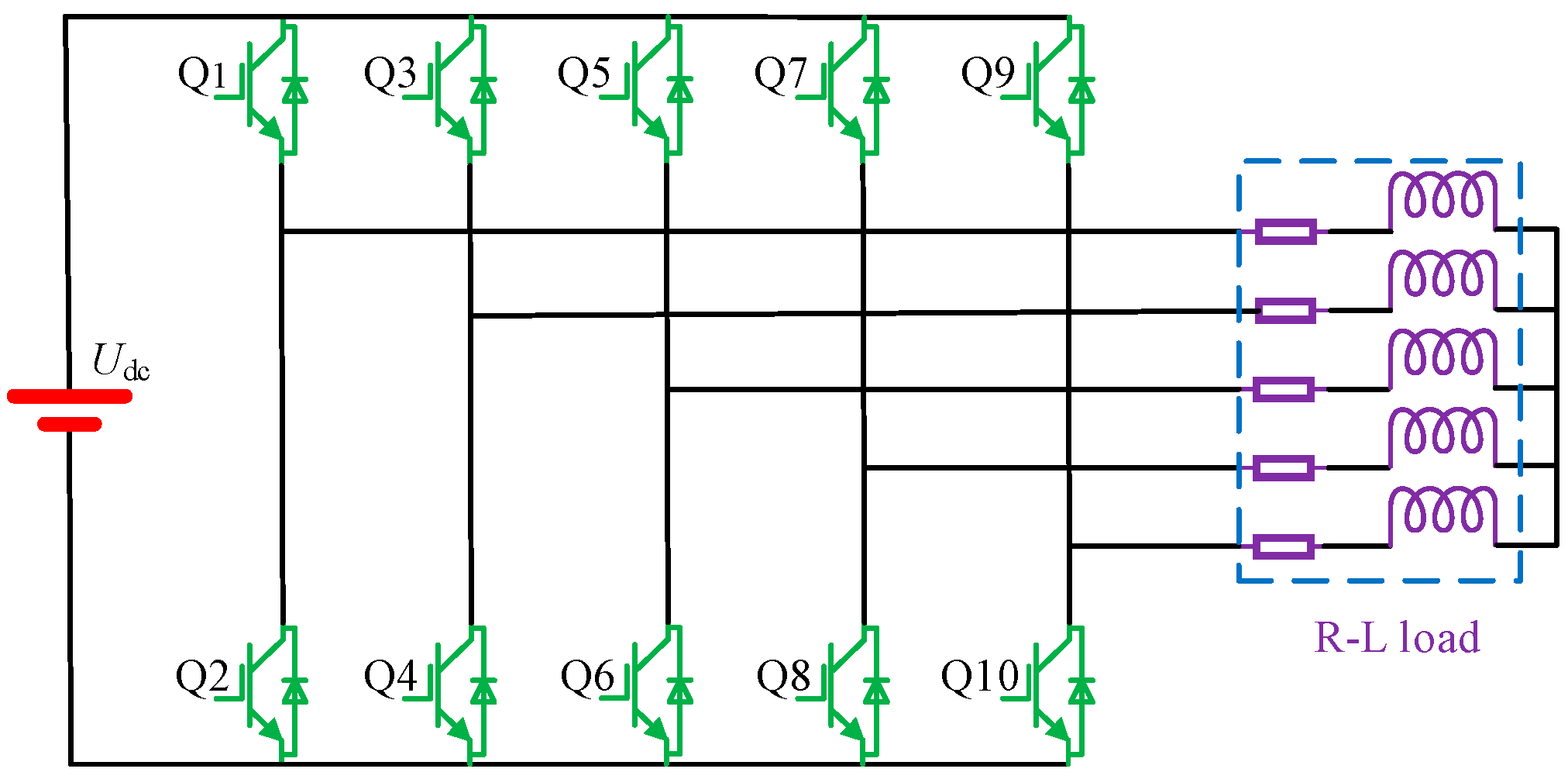



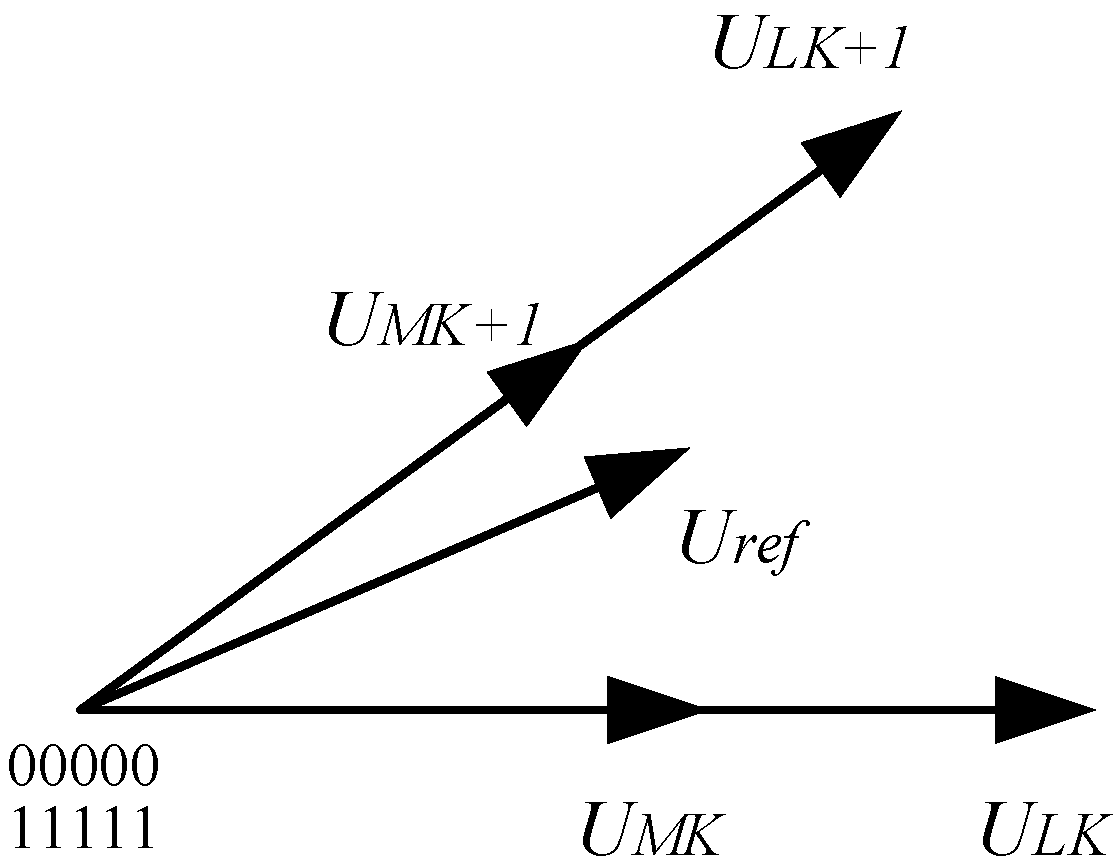



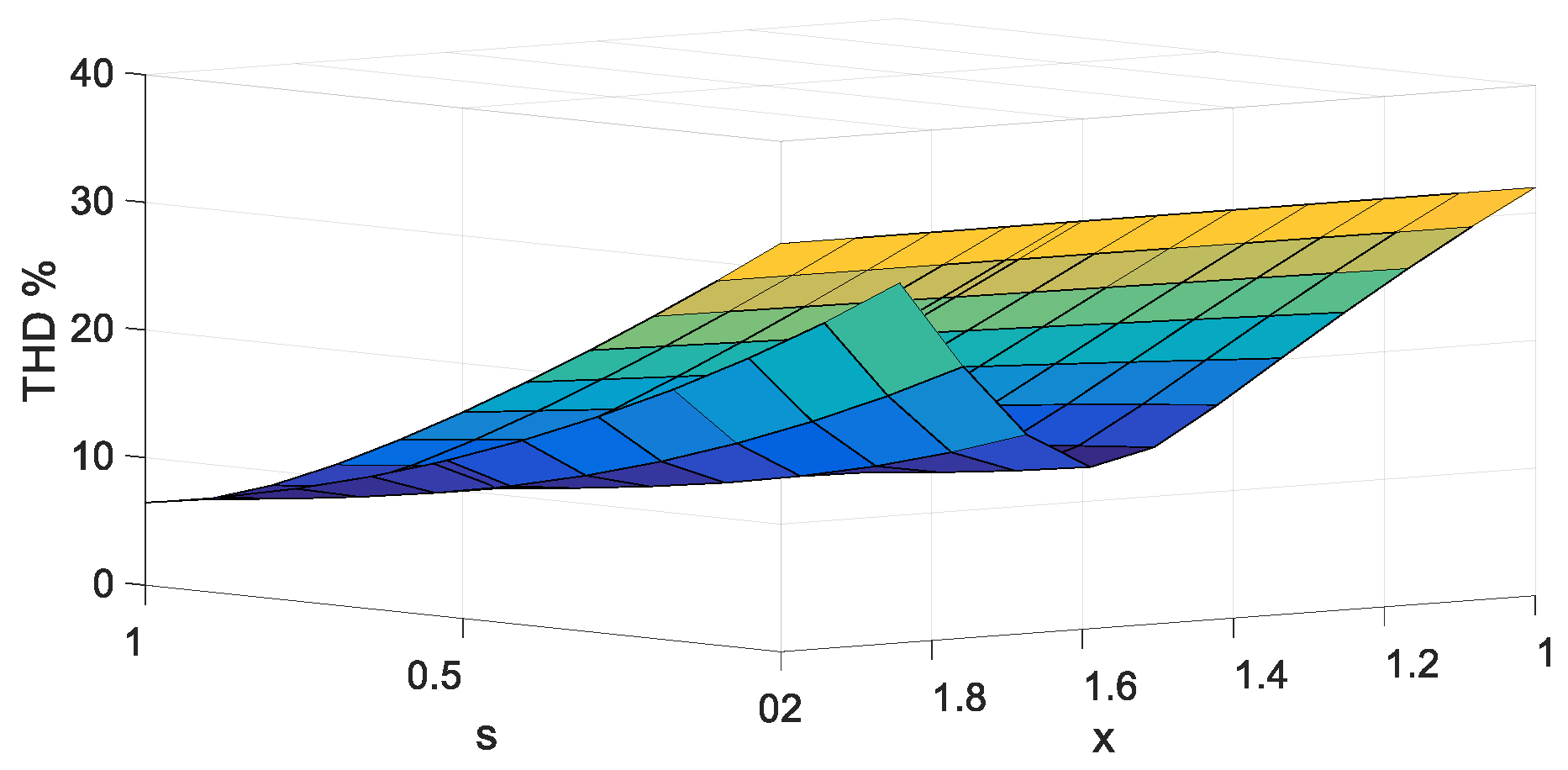
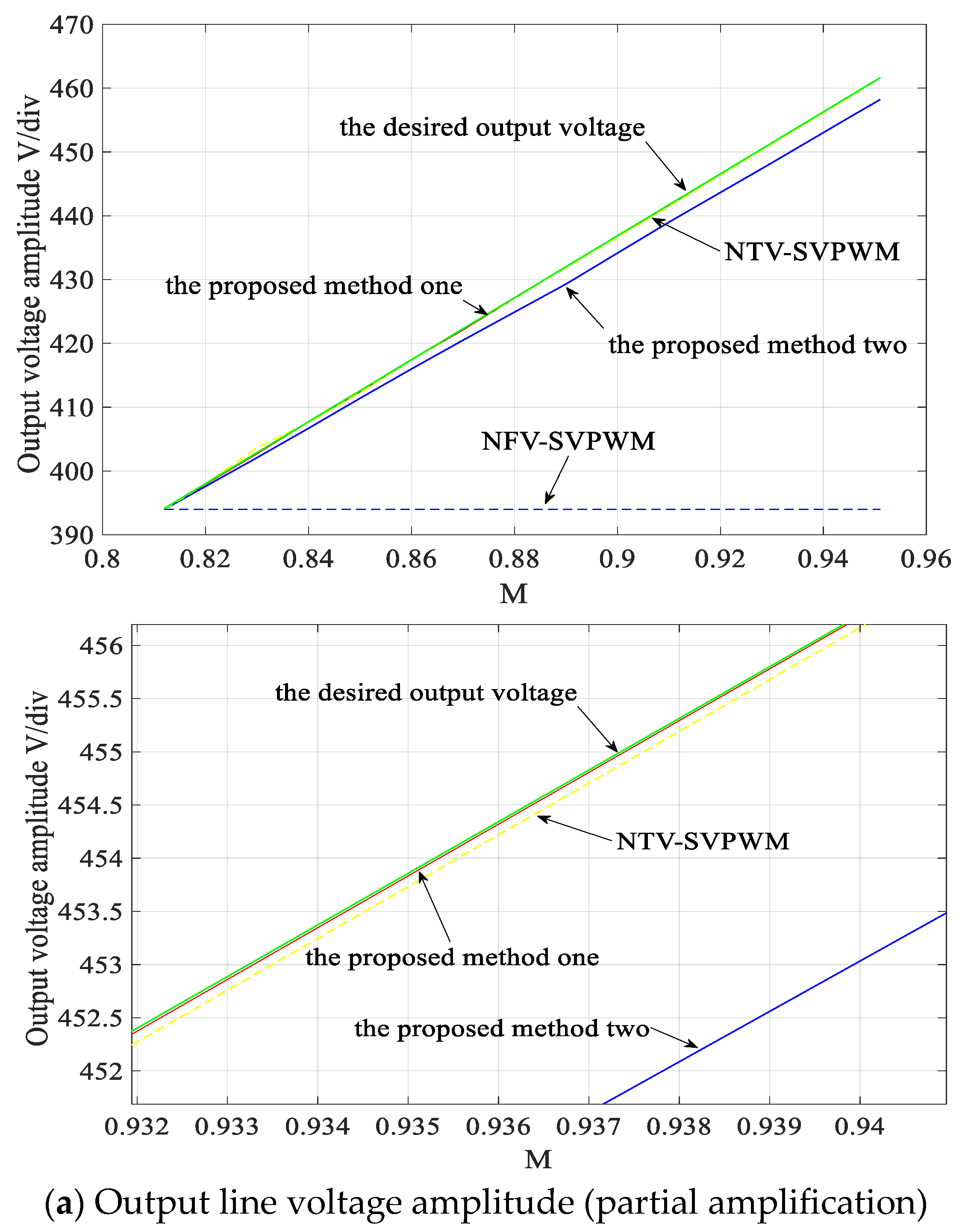
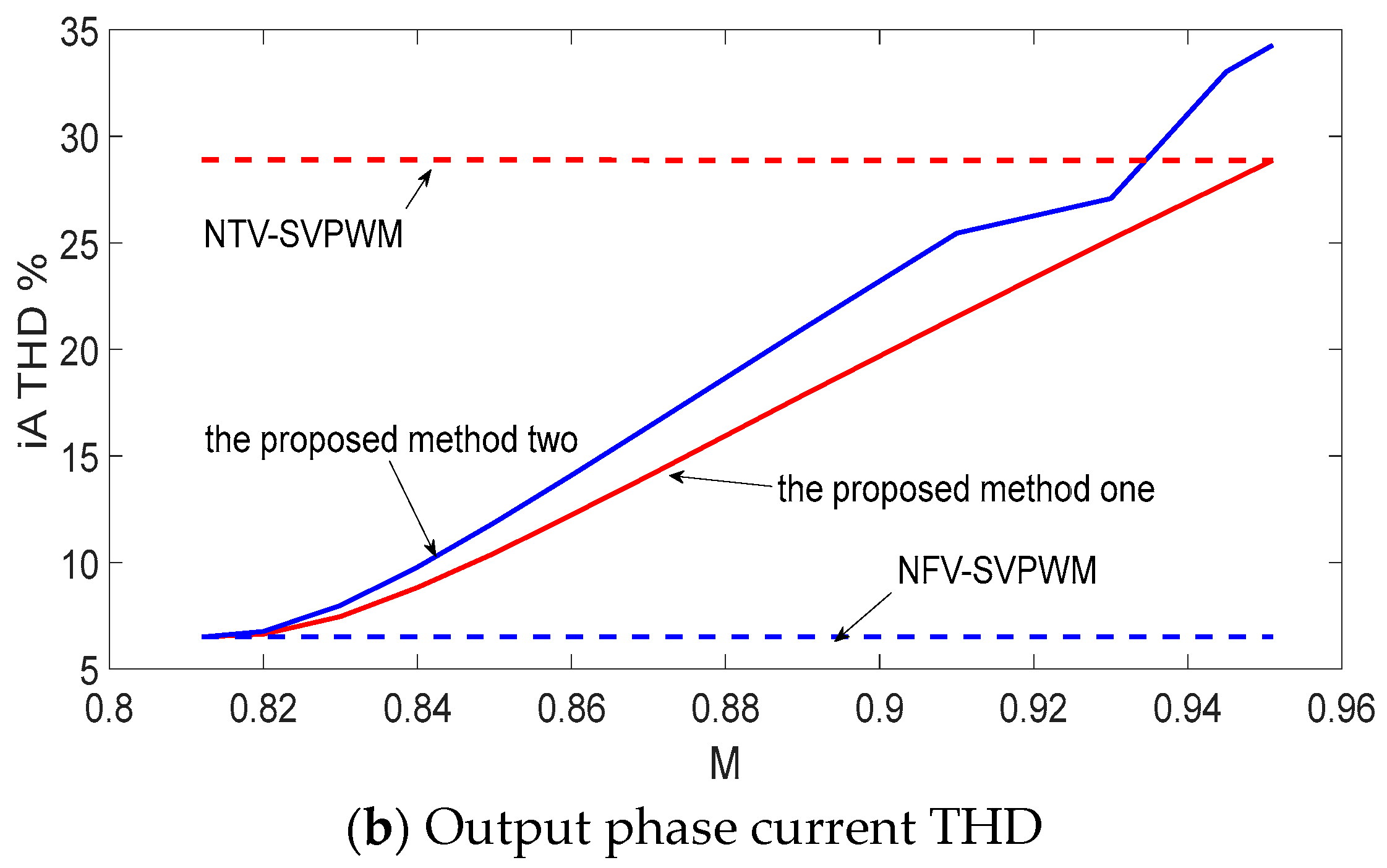

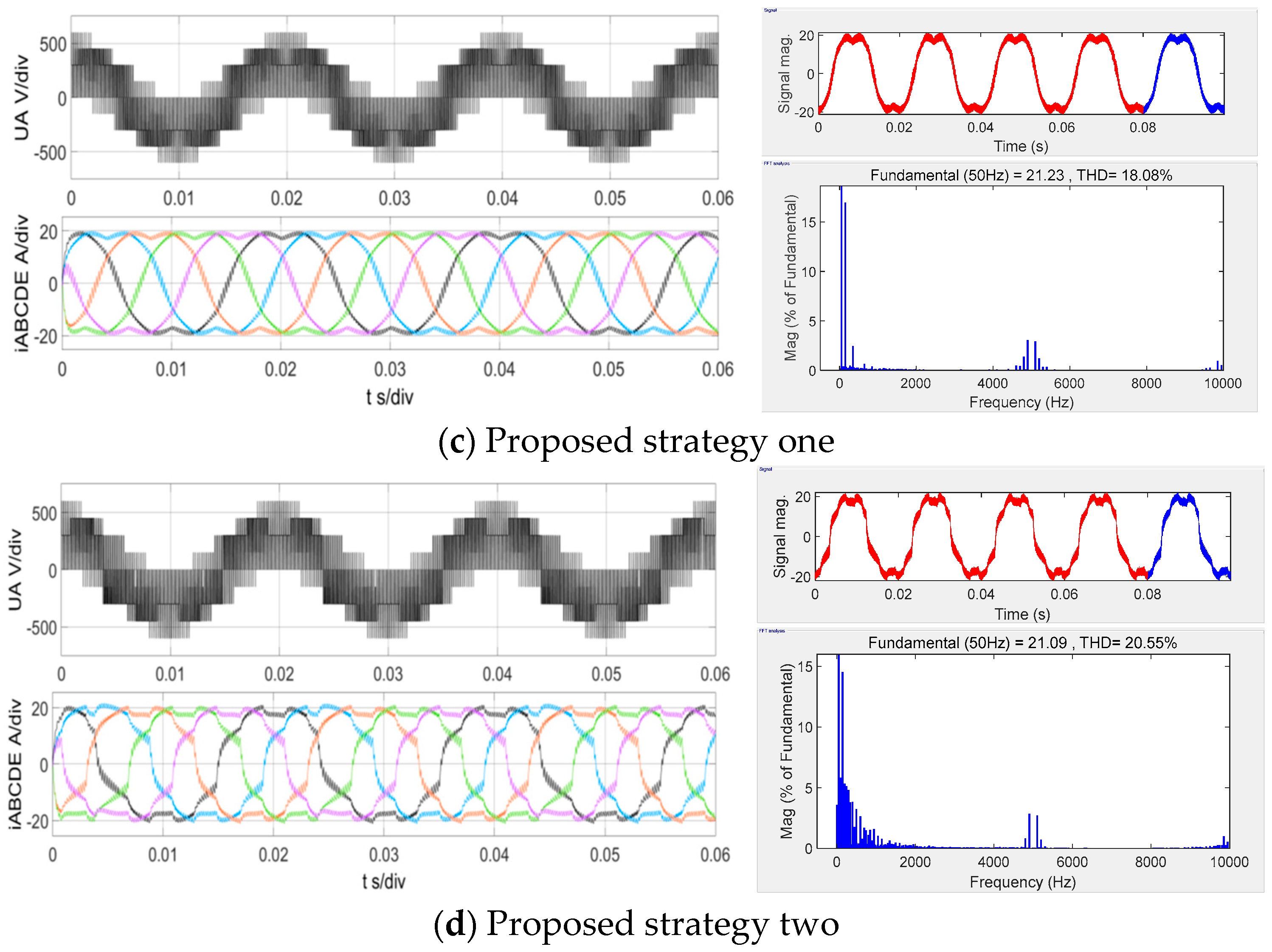
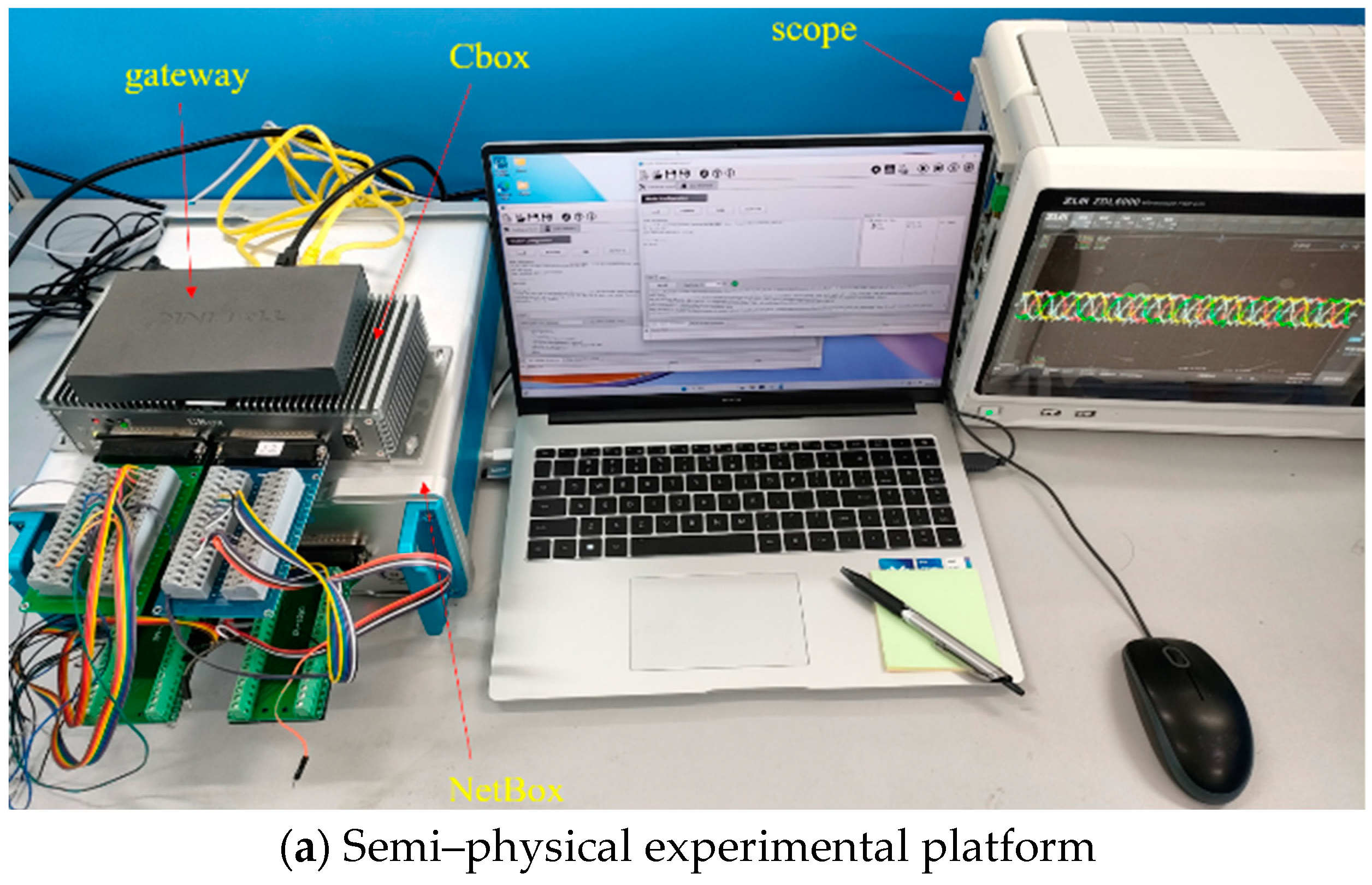

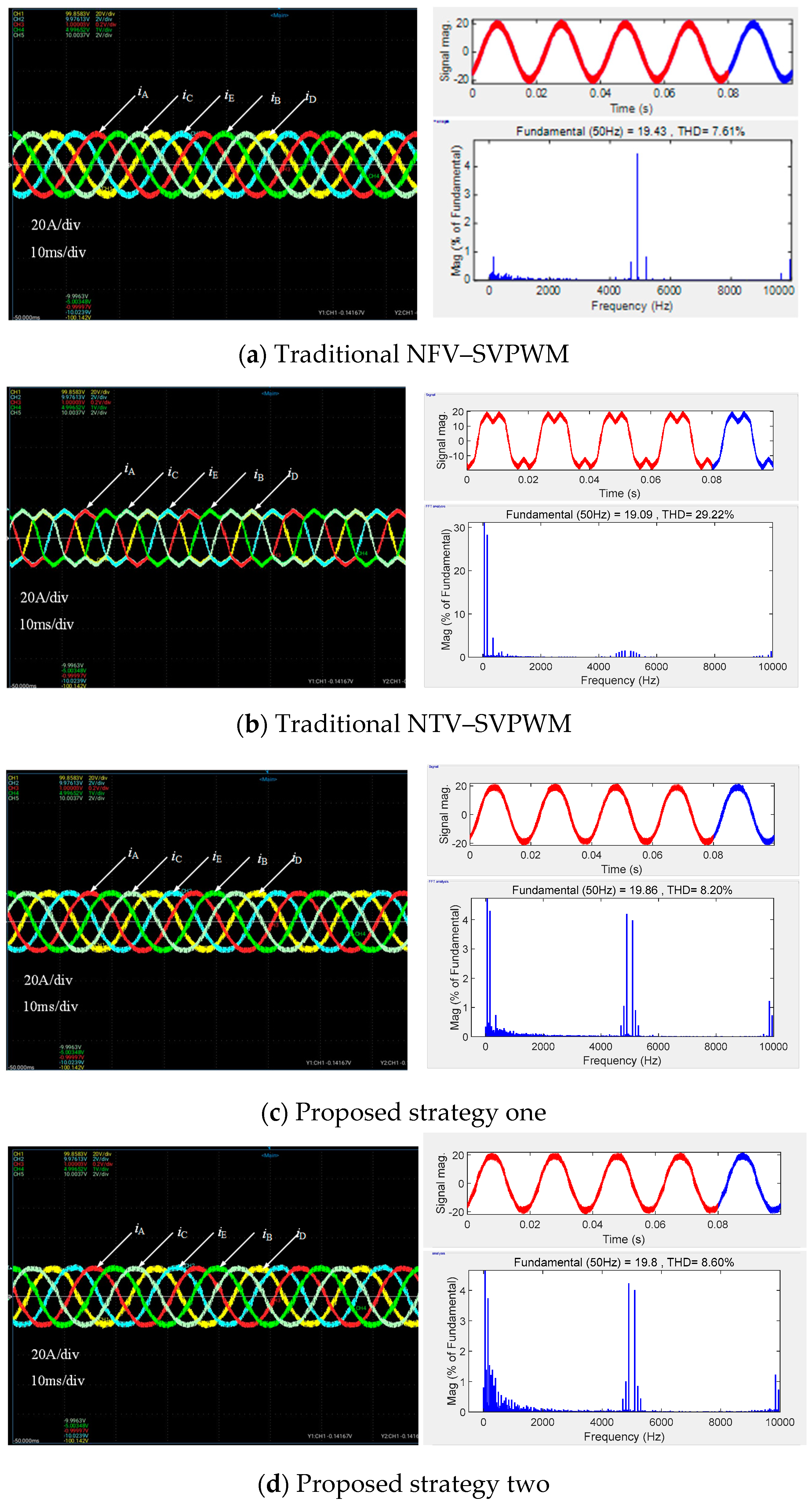
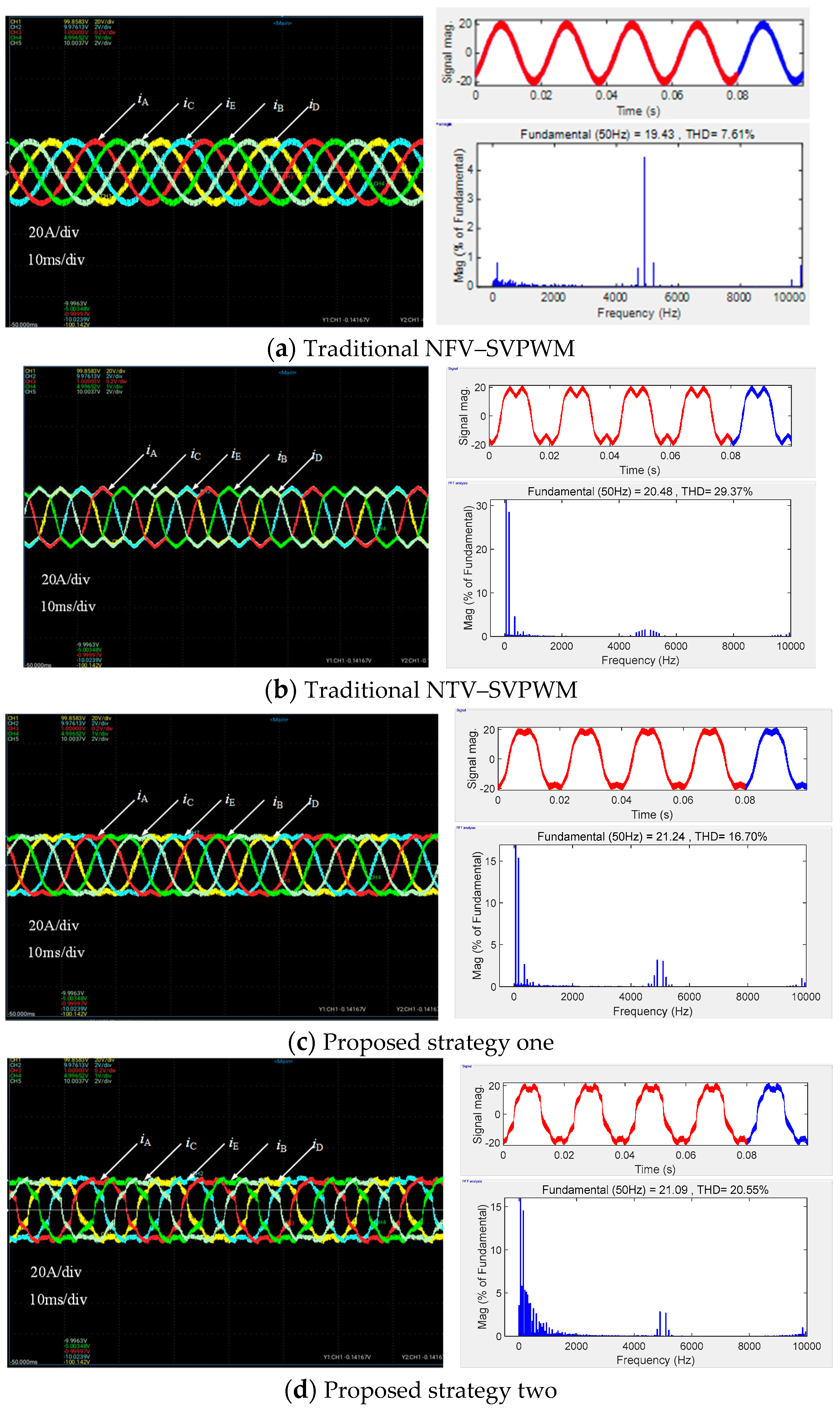

| Voltage Vector | Amplitude | |
|---|---|---|
| Large vector | U3, U6, U7, U12, U14, U17, U19, U24, U25, U28 | |
| Medium vector | U1, U2, U4, U8, U15, U16, U23, U27, U29, U30 | |
| Small vector | U5, U9, U10, U11, U13, U18, U20, U21, U22, U26 |
| Parameter | Value |
|---|---|
| DC voltage/DC capacitance | 750 V/4700 uF |
| Output voltage/frequency | 380 V/50 Hz |
| R–L load | R = 20 Ω, L = 5 mH |
| Switching frequency fs | 5 kHz |
| Comparative Indicators | NFV–SVPWM | NTV–SVPWM | Improved SVPWM Strategy I | Improved SVPWM Strategy II |
|---|---|---|---|---|
| Output voltage error | low | low | less | smaller |
| Total harmonic distortion (THD) | low | high | higher | lower |
| Modulation ratio (M) | 0.812 | inapplicable | 0.915 | 0.915 |
| Experimental validation results | practicable | practicable | practicable | practicable |
Disclaimer/Publisher’s Note: The statements, opinions and data contained in all publications are solely those of the individual author(s) and contributor(s) and not of MDPI and/or the editor(s). MDPI and/or the editor(s) disclaim responsibility for any injury to people or property resulting from any ideas, methods, instructions or products referred to in the content. |
© 2024 by the authors. Licensee MDPI, Basel, Switzerland. This article is an open access article distributed under the terms and conditions of the Creative Commons Attribution (CC BY) license (https://creativecommons.org/licenses/by/4.0/).
Share and Cite
Jing, M.; Xia, Y.; Zhang, B. Research on Two Improved High–Voltage–Transfer–Ratio Space–Vector Pulse–Width–Modulation Strategies Applied to Five–Phase Inverter. Electronics 2024, 13, 1546. https://doi.org/10.3390/electronics13081546
Jing M, Xia Y, Zhang B. Research on Two Improved High–Voltage–Transfer–Ratio Space–Vector Pulse–Width–Modulation Strategies Applied to Five–Phase Inverter. Electronics. 2024; 13(8):1546. https://doi.org/10.3390/electronics13081546
Chicago/Turabian StyleJing, Mingchen, Yihui Xia, and Bin Zhang. 2024. "Research on Two Improved High–Voltage–Transfer–Ratio Space–Vector Pulse–Width–Modulation Strategies Applied to Five–Phase Inverter" Electronics 13, no. 8: 1546. https://doi.org/10.3390/electronics13081546




